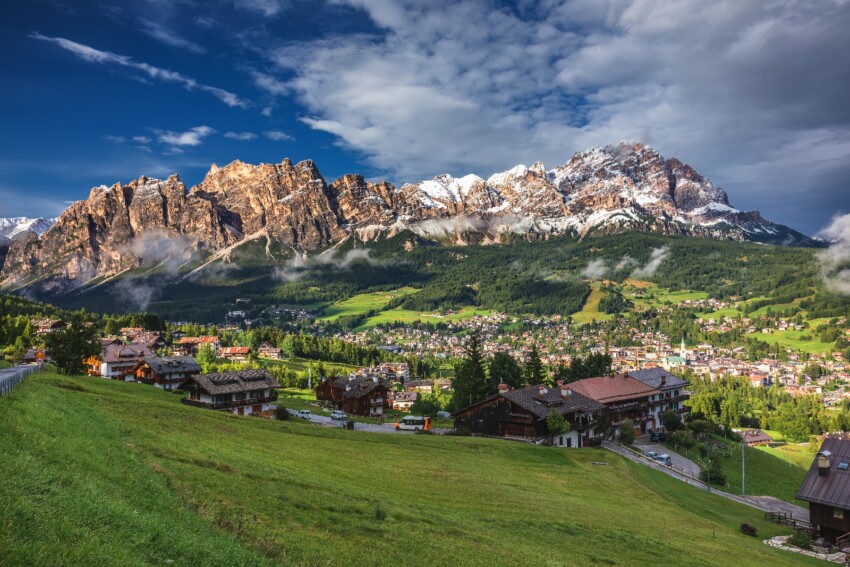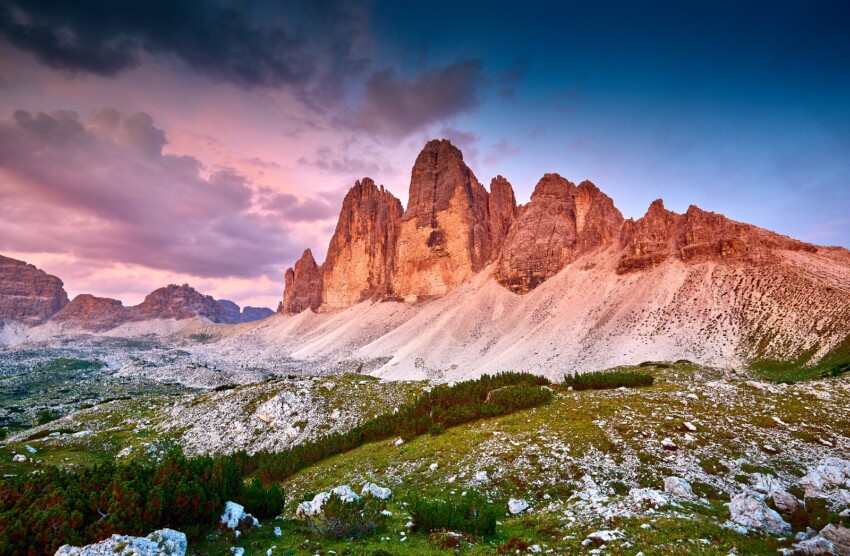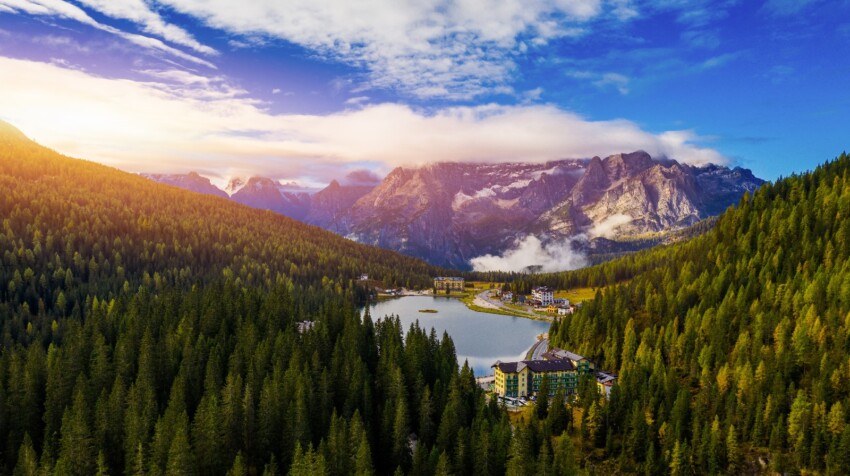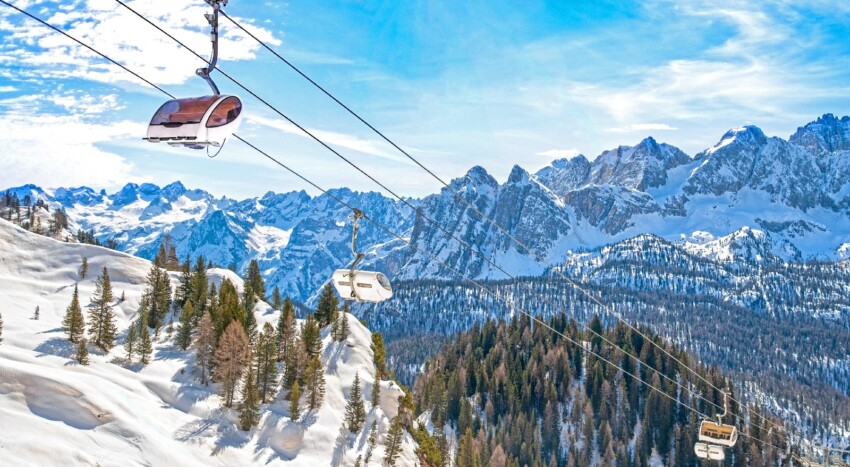

Cortina d’Ampezzo is perhaps the only VIP mountain resort that fails to turn up the noses of outdoor holiday purists. Too beautiful are the mountains that frame it, too spectacular are the views from the ridges and vantage points: all is forgiven.
Lying along the Ampezzo Valley, a wide, sun-kissed basin surrounded by majestic peaks including six peaks over 3000 metres, Cortina leaves everyone speechless. This is why, despite its reputation as an exclusive and fashionable resort (a snob, let’s face it), the Queen of the Dolomites still attracts a very diverse public, ranging from boisterous fans of the cinepanettoni film series on the hunt for autographs of the hottest model of the moment to taciturn mountaineers in search of absolute silence to be conquered by arduous climbs.
At the beginning of the 20th century, the star of Italian mountain tourism was an unknown village; the First World War left deep wounds, evidence of which can still be seen today in open-air war museums.
1956 is the historic date that changed the physiognomy of Cortina forever: in that year the Winter Olympics were held, an event that put the town in the international spotlight and turned it into one of the most famous holiday destinations in the world.
It can be visited in all seasons and in all ways. What is your Cortina? A VIP holiday made up of 5-star hotels, boutique shopping, glamorous aperitifs and discos to be documented with an appropriate number of selfies to brag to friends back home? A skiing holiday to learn from scratch or to experience the thrill of skiing the same slopes as the champions? A slow-paced walking holiday that takes you high into the sky? A romantic getaway to experience sweet nights snuggled up in a warm alpine chalet? Or a fun family holiday to spend unforgettable days together?
Whatever you want, the Queen will know how to please you.
The other mountain resorts are ‘only’ scenic beauties. Cortina’s attractions are another world: alongside dreamy landscapes, all lists of things to see in Cortina also include an unusual number of museums and famous sights. Invariably, however, the mountains and greenery manage to steal the show from the gilded worldly life.
Between nature and VIP spots, here are the attractions not to be missed in Cortina.
Corso Italia is Cortina’s main street and the nerve centre of Cortina’s social life. A stroll through this town salon is a must, whether to browse through the shop windows or to try and spot some VIPs… but almost everyone comes here mainly to say they’ve been there.
If you are a shopaholic, you will need at least a couple of hours for a full visit to the shops in Corso Italia. Bank account permitting, you can buy everything from fine jewellery to technical sports equipment via designer clothes, souvenirs, typical Dolomite products, toys and more.
Corso Italia, however, is not just boutiques: along the street you will also come across interesting cultural attractions such as the Basilica of Saints Philip and James and the Ciasa de Ra Regoles, an elegant 19th-century building that represents one of the best examples of Austrian urban construction of the time.
The most imposing mountains of the Ampezzo Dolomites are the Tofane, three majestic peaks over 3000 metres high: Tofana di Mezzo (3244 m), Tofana di Dentro or Tofana Terza (3238 m) and Tofana di Rozes or Roces (3225 m).
All three are criss-crossed by numerous paths and equipped routes that offer endless walking, via ferrata and climbing possibilities for all levels.
It is possible to reach the highest peak by a cable car departing from the centre of Cortina: well deserving of the evocative name ‘Arrow in the Sky‘ is this 5 km long cable car. There are three stations on the route: Col Drusciè, Ra Valles and Cima Tofana di Mezzo.
An iconic place in the surroundings of Cortina is the Giau Pass: situated at an altitude of 2236 metres, it connects Cortina d’Ampezzo with the villages of Colle Santa Lucia and Selva di Cadore.
This legendary alpine pass in the Dolomites has been the protagonist on several occasions of epic sporting feats, including some stages of the Giro d’Italia that have become legendary for their hardness.
From here it is possible to set off on wonderful excursions on foot, by bicycle and motorbike, or to reach the Lagazuoi-Cinque Torri ski lifts.

It is impossible to come to Cortina and not want to see the Tre Cime di Lavaredo: these three mountains with their unmistakable profile have become the symbol of the Dolomites and are one of the unmissable attractions of Cortina and its surroundings.
The toll-free panoramic road leading to the Auronzo hut, the starting point of the Tre Cime Walking Tour, begins in Misurina, a town only 14 km from Cortina.
Once you arrive at the hut, you can follow an easy circular hiking route that allows you to admire the three most famous majestic rock faces of the Dolomites at close quarters. An unmissable view!

A must for anyone wishing to visit the Tre Cime, Misurina is also the ideal location for a day of relaxation.
Misurina’s main attraction is its lake, of glacial origin: you can sunbathe on the lake beach, take a swim or a boat ride, or stroll along the cycle-pedestrian path that runs along both shores. The waters of the lake reflect some of the most beautiful mountains of the Dolomites, including the Tre Cime.
A symbolic building of Cortina’s transformation into a star of international tourism is the historic Ice Palace built for the 1956 Winter Olympics. Used as the venue for the official opening ceremony, it was the largest and most important of the sports facilities built for that occasion.
Completely refurbished in recent years, it is now an indoor ice stadium open in all seasons, equipped with a 30×60-metre rink, solarium, children’s play area, skateboarder’s area and many modern facilities.
The stadium is used for training by competitive sports clubs and for sports and cultural events; when not used for training or events, it is open as a public sports facility. Private skating lessons can be booked.
In 10 minutes from the centre of Cortina, it is possible to reach the Rifugio Faloria, located at an altitude of 2120 metres, by cable car (in the event of cable car closure for maintenance, a replacement jeep service is provided). From here, numerous hiking trails, mountain bike trails, climbing routes and an easy film-themed route known as the Cliffhanger Lodge start.
It is a loop trail starting and returning to the lodge on almost flat terrain. Along the route, which runs along the ridge overlooking Cortina, there are numerous vantage points from which to admire beautiful views. The main attraction of the trail, however, is the old Faloria cable car station, which appears in the film ‘Cliffhanger – the Last Stand’ starring Silvester Stallone.
This high-altitude walk is easy and suitable for everyone. However, suitable clothing for high mountain walks is recommended.
Have you ever walked behind a noisy waterfall? You can enjoy this unique experience with a tour to the Fanes Waterfalls.
Of the many watercourses flowing through the mountains and valleys of the Dolomites, the Fanes stream is one of the most famous: a fame earned thanks to its copious waters, which, squeezed between imposing rock faces, cascade into pools, cataracts and tumultuous waterfalls (among the highest waterfalls in the Dolomites).
The best way to admire them in all their spectacularity is to follow a path with some sections equipped with metal ropes; although it is in fact a via ferrata, the route is easy and suitable even for children if accompanied by an expert guide.
If you do not feel up to tackling the mini-ferrata, you can admire the gorge of the Rio Fanes from the Ponte Alto-Ponte Outo: it is a suspension bridge about 80 metres high, which can be reached in about an hour’s walk via path no. 10, which starts from the locality of Pian de Loa.
Suitable for young and old, the Rinaldo Zardini Palaeontological Museum displays a collection of fossils from the Triassic period found in the valleys and mountains around Cortina.
You can admire the shells of marine invertebrates, megalodonts, sponges, corals and other fossils that clearly testify to the true origin of the pearl of the Dolomites: thousands and thousands of years ago, the Cortina area was in fact an immense expanse of sea water!
A special museum in Cortina, not to be missed by those who want to learn more about life in the Dolomites, is the Ethnographic Museum of Regole d’Ampezzo, entirely dedicated to the collective property of the Cortina d’Ampezzo valley, a centuries-old tradition that has forged the image and culture of this area.
Housed in the prestigious premises of Ciasa da Se Regola, the Cortina Museum of Modern Art exhibits the private collection of Mario Rimoldi, an art lover and politician who became famous for being the mayor of the town during the 1956 Olympic Games.
The collection includes works by famous artists such as Savinio, Garbari, Depero, Guttuso, De Chirico, De Pisis and others.
The most popular day trip from Cortina is to Lake Braies, a mountain resort in Trentino Alto Adige that became famous thanks to the TV series ‘One Step from Heaven’. The distance is about 50 km.
In the following map you can see the location of the main places of interest mentioned in this article.
If you have no interest in shopping and worldliness, get out in the fresh air: whether summer or winter matters little, the amount of things to do in Cortina in all seasons is impressive. There really is something for everyone.

Cortina d’Ampezzo is synonymous with skiing weeks and ski cups. Its legendary slopes, where ‘common mortals’ have learned to ski and champions have written the history of competitive skiing, make it one of the most popular destinations for Italian and European skiers.
Cortina’s fame as a ski resort was established with the Winter Olympics and is carried on every year by the World Cup race held on the Olympia slope on the Tofane. Cortina is also a founding member of the Dolomiti Superski, a ski area that unites 12 different resorts with a total of over 1,200 km of slopes under a single ski pass.
In the Cortina area alone, you can enjoy over 30 lifts and 70 slopes, of which about 25 per cent are for expert skiers and 40 per cent beginners. If you have no experience, you are in the right place: taking private ski lessons in Cortina is the best.
Many popular lifts can be reached by public ski buses, which can be used free of charge if you have a ski pass.
Downhill skiing is undoubtedly the most popular sport in Cortina, but the mountains and sports facilities in the area offer the possibility of practising numerous other winter sports, including well-known ones and others that are still ‘niche’.
A few examples? Alpine skiing, Nordic skiing, snowkiting, snowboarding, snowshoeing, fat biking, curling, dog sledding.
A fun way to enjoy the snow in Cortina is to treat yourself to a snowmobile excursion; if you are looking for an adrenalin rush, try heli-skiing, a combination of helicopter excursion and off-piste skiing accompanied by a mountain guide.
From spring to late summer, hiking is the most popular activity in Cortina: you can choose from a wide variety of trails, from easy valley walks to challenging multi-day high altitude treks, totalling more than 400 km to walk.
Thanks to the ski lifts in operation even in summer, the thrill of a hike in the high mountains is not only reserved for trained hikers.
If you have no experience of walking in the high mountains, however, consider a guided trek: you can enjoy it peacefully, in complete safety, and your guide will give you interesting information about the flora, fauna and legends of the area. You can book a trek online conveniently before departure.
Would you like to raise the bar of thrills a bit? Leave the easier hiking trails and follow a via ferrata. There are no less than 5,560 km of equipped trails and via ferratas in the immediate vicinity of Cortina, plus many more that can be reached on a day trip. Climbing enthusiasts can also indulge in vertical experiences of all levels.
If you have never tried a via ferrata or climbing before, you can book a beginner level excursion; a mountain guide will teach you how to move safely and accompany you along the route.
In Cortina, fun is also on two wheels. Mountain bikers can explore the magnificent mountains and valleys of Cortina and the surrounding area by following specific mountain bike routes.
For greater safety, choose the official Bike Resort routes: there are various levels, from those for children to those for competitive bikers, and range from family-friendly itineraries with no demanding gradients to adrenalin-pumping descents reserved for expert freeriders.
A very beautiful route also suitable for families is the Dolomites cycle path: from Cortina you can ride it in the direction of Cimabanche or Borca. If you want to enjoy the landscape without exerting yourself, you can rent an ebike.
Repeated use of the lifts can have a considerable impact on the cost of your holiday. If you plan to use them several times for hiking, cycling, skiing or climbing, consider buying a lift pass.
There are several, including the Cortina Vertical Pass or the Dolomiti SuperSummer Card, and they can be value or time-based (3 to 7 days).
The amount of services available, far superior to a normal mountain resort, and the variety of attractions for all ages make Cortina d’Ampezzo an ideal destination for a family mountain holiday.
The sour note is that a family holiday in Cortina can cost quite a lot: to keep your budget under control, it is best to organise it well and book well in advance.
Many of Cortina’s scenic beauties can be admired without the need for strenuous sporting endeavours: you won’t have to give up the most beautiful views of the Dolomites if you are travelling with your children. And even if you love walking, you won’t have to make any sacrifices because among the hundreds of trails that criss-cross the mountains around Cortina, there are some easy ones suitable for inexperienced walkers and small children.
The famous ‘Giro delle Tre Cime’ (Tour of the Three Peaks) can also be done with a pushchair, although it is a little uncomfortable; if you want to enjoy it more, just use a mountain baby backpack.
For new mothers who want to get into shape soon, there are the Fit Moms walks, which take place on beautiful paths that can be easily covered with a pushchair.
For a day of family fun, you can go to the Cortina Adrenalin Center adventure park in the village of Ronco: it is one of the largest in Italy and has no fewer than 15 courses of increasing difficulty suitable for children, teenagers and adults, covering a total of 1,300 metres and 140 passages.
Your children will be eternally grateful for this adrenaline-filled day spent among Tibetan bridges, nets, suspended crossings and jumps into the void.
The most curious children – and the most romantic parents – may like the Helmut Ullrich Astronomical Observatory, the right place to admire the starry sky of the Dolomites. It is located at Col Dusciè, at an altitude of 1780 metres above sea level, and can be visited both day and night.
In the summer months, astrocene, dinners at the Col Drusciè hut followed by guided tours of the observatory, are organised.
Two other family-friendly attractions not to be missed in Cortina are the Trenino delle Dolomiti, a tourist train that connects the centre of Cortina with Campo di Sotto, the Pierosà playground and the ice stadium, and the Via dei Dinosauri, an easy walking trail that takes you to discover the traces left by prehistoric reptiles.
Cortina d’Ampezzo is one of the very few mountain resorts suitable for those who like to have fun and stay out late.
Aperitifs in Cortina in winter are synonymous with après ski: at the end of a day on the slopes, everyone gathers in the chic bars of the centre to brag about their achievements; drinks and DJ sets complete the setting for these elegantly light-hearted conversations. In summer, the ritual is practically the same, with the only variation being that people sit at outdoor tables instead of inside the premises.
After dinner, everyone goes dancing in one of Cortina’s most famous discos, such as the Bilbò Club in the centre or the Discoteca Belvedere in the hamlet of Pocol.
If you want to aim for the best – or have a better chance of spotting celebrities – head for the VIP Club: this is the historic venue that forged Cortina’s nightlife, transforming itself from a simple tavern for Hotel Europa guests first into a piano bar then into a cult venue with an American bar and disco. Its DJ sets, animated by internationally renowned DJs, hold their own against the dance events of the most famous seaside resorts.
Remember though: disco and sporting endeavours do not go together. If you want to indulge in unbridled fun for the next day, plan some easy outings that allow you to leave your hotel late in the morning… or after lunch, depending on how much sleep you need to regain your strength!
Cortina is a real diva: it has served as a film set for more than a hundred films. The list of films shot in Cortina includes Vittorio De Sica’s masterpiece ‘Count Max’ and numerous blockbuster titles that have entered the collective imagination, including ‘The Pink Panther’ and a chapter in the James Bond saga (‘For Your Eyes Only’, starring Roger Moore).
If you want to take a film-themed tour of Cortina, mark down the must-see places: Hotel de La Poste, Hotel Miramonti and the aforementioned VIP Club and Cliffhanger Lodge.
Cortina d’Ampezzo is one of the most touristy mountain resorts in the whole of Italy and probably Europe, so it is not surprising to find such a large amount of accommodation.
Cortina’s reputation as a chic resort does not do justice to the wide choice of hotels, B&Bs and flats available in and around the town, which includes not only the exclusive 4- and 5-star hotels that have made it famous, but also solutions suitable for different types of holidays and for (almost) any budget.
If you come to Cortina for the high society, the ideal solution for you is a hotel in the centre, perhaps overlooking the famous Corso Italia. For the ultimate in luxury, treat yourself to a splendid spa hotel with a mountain view, perfect for a couple’s holiday or a special occasion.
Ski hotels are facilities that focus more on comfort than sophistication and are strategically located to reach the slopes; the best ones offer specific services such as a shuttle to the ski lifts, ski equipment repair and heated ski and boot storage.
Already from 3-4 kilometres away from the centre, the prices of hotels in Cortina begin to fall and it is possible to find family-run 2 or 3-star hotels, guesthouses and simple but comfortable holiday homes almost always surrounded by greenery. These are the ideal solutions for a nice holiday without draining your wallet.
Mind you, cheap accommodation in Cortina is a rarity: if you are on a tight budget, book as early as possible. Consider sleeping in a flat or camping to save on lunches and dinners.
Cortina d’Ampezzo is an easily accessible mountain resort both by car and public transport.
If you travel by car, don’t be afraid: you won’t have to take any of those scary mountain roads with overhangs in sight.
You approach it by motorway, the A27 Venezia-Belluno if you come from the south (Belluno exit) and the A22 Brennero-Modena (Bressanone exit) if you come from the north, and you arrive at your destination via a state road (SS51 in the first case, SS49 and then SS51 bis in the second).
Worldly Cortina does not have a station. The nearest railway stations to Cortina are Calalzo-Pieve di Cadore-Cortina (about 34 km from the centre) and Dobbiaco (30 km). Both are served by direct buses to Cortina; running times coincide with train arrival times.
Cortina can be reached by bus from Venice airport with a direct bus of the Cortina Express company. It is also connected to other tourist resorts in the province of Belluno and Alto Adige by local buses.
What's the weather at Cortina d’Ampezzo? Below are the temperatures and the weather forecast at Cortina d’Ampezzo for the next few days.
Cortina d'Ampezzo is a municipality in the province of Belluno located in the northern part of Veneto, less than 20 km from the border with Trentino Alto Adige. It is part of Ladinia, a historical-geographical region comprising five Ladin-speaking valleys straddling the two regions.
Situated in the centre of the Conca d'Ampezzo at an altitude of 1224 metres above sea level, it is surrounded by the Ampezzo Dolomites, a mountain group most of whose territory falls within a regional nature park.